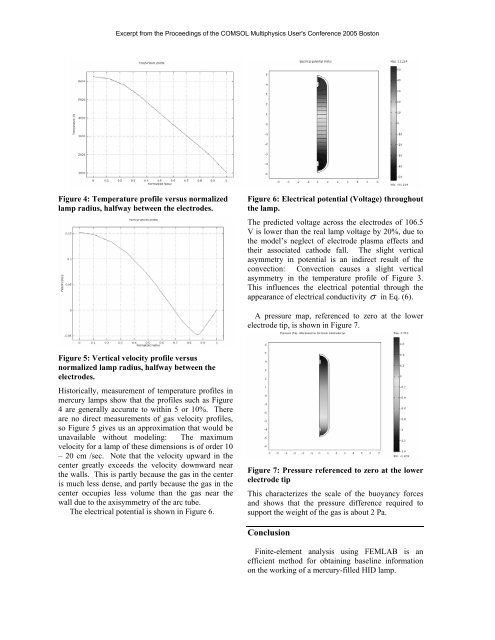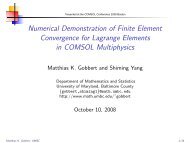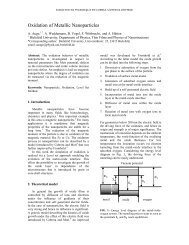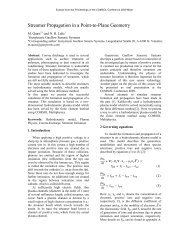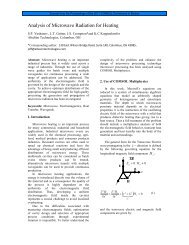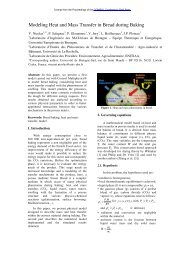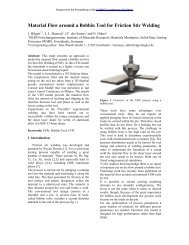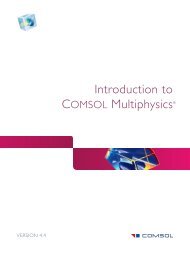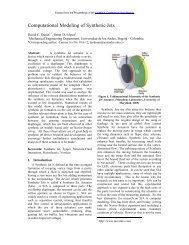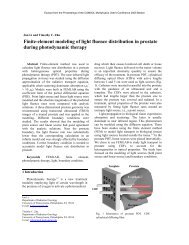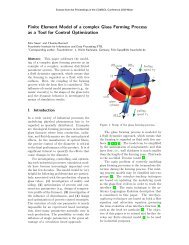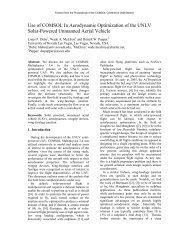Simulation of heat and momentum flow in a quartz mercury ... - Comsol
Simulation of heat and momentum flow in a quartz mercury ... - Comsol
Simulation of heat and momentum flow in a quartz mercury ... - Comsol
- No tags were found...
You also want an ePaper? Increase the reach of your titles
YUMPU automatically turns print PDFs into web optimized ePapers that Google loves.
Excerpt from the Proceed<strong>in</strong>gs <strong>of</strong> the COMSOL Multiphysics User's Conference 2005 BostonFigure 4: Temperature pr<strong>of</strong>ile versus normalizedlamp radius, halfway between the electrodes.Figure 6: Electrical potential (Voltage) throughoutthe lamp.The predicted voltage across the electrodes <strong>of</strong> 106.5V is lower than the real lamp voltage by 20%, due tothe model’s neglect <strong>of</strong> electrode plasma effects <strong>and</strong>their associated cathode fall. The slight verticalasymmetry <strong>in</strong> potential is an <strong>in</strong>direct result <strong>of</strong> theconvection: Convection causes a slight verticalasymmetry <strong>in</strong> the temperature pr<strong>of</strong>ile <strong>of</strong> Figure 3.This <strong>in</strong>fluences the electrical potential through theappearance <strong>of</strong> electrical conductivity σ <strong>in</strong> Eq. (6).A pressure map, referenced to zero at the lowerelectrode tip, is shown <strong>in</strong> Figure 7.Figure 5: Vertical velocity pr<strong>of</strong>ile versusnormalized lamp radius, halfway between theelectrodes.Historically, measurement <strong>of</strong> temperature pr<strong>of</strong>iles <strong>in</strong><strong>mercury</strong> lamps show that the pr<strong>of</strong>iles such as Figure4 are generally accurate to with<strong>in</strong> 5 or 10%. Thereare no direct measurements <strong>of</strong> gas velocity pr<strong>of</strong>iles,so Figure 5 gives us an approximation that would beunavailable without model<strong>in</strong>g: The maximumvelocity for a lamp <strong>of</strong> these dimensions is <strong>of</strong> order 10– 20 cm /sec. Note that the velocity upward <strong>in</strong> thecenter greatly exceeds the velocity downward nearthe walls. This is partly because the gas <strong>in</strong> the centeris much less dense, <strong>and</strong> partly because the gas <strong>in</strong> thecenter occupies less volume than the gas near thewall due to the axisymmetry <strong>of</strong> the arc tube.The electrical potential is shown <strong>in</strong> Figure 6.Figure 7: Pressure referenced to zero at the lowerelectrode tipThis characterizes the scale <strong>of</strong> the buoyancy forces<strong>and</strong> shows that the pressure difference required tosupport the weight <strong>of</strong> the gas is about 2 Pa.ConclusionF<strong>in</strong>ite-element analysis us<strong>in</strong>g FEMLAB is anefficient method for obta<strong>in</strong><strong>in</strong>g basel<strong>in</strong>e <strong>in</strong>formationon the work<strong>in</strong>g <strong>of</strong> a <strong>mercury</strong>-filled HID lamp.


